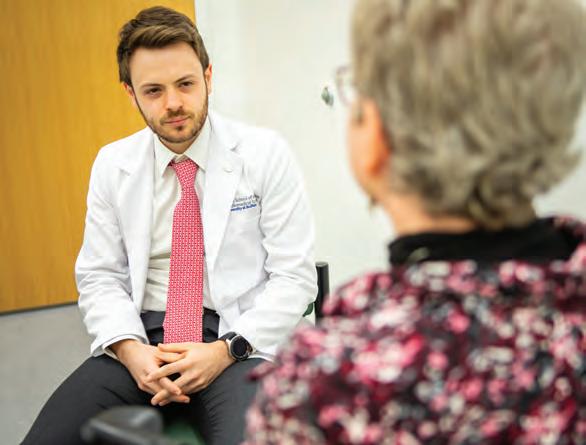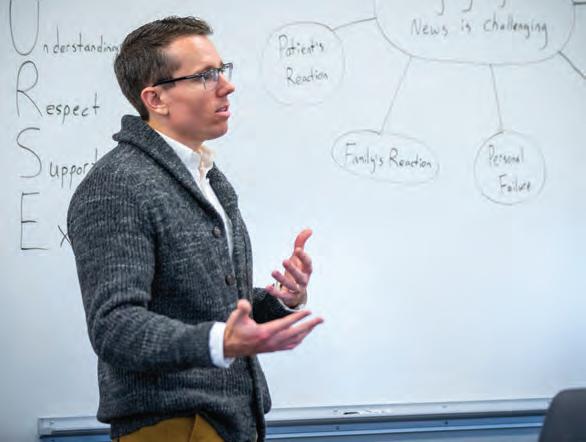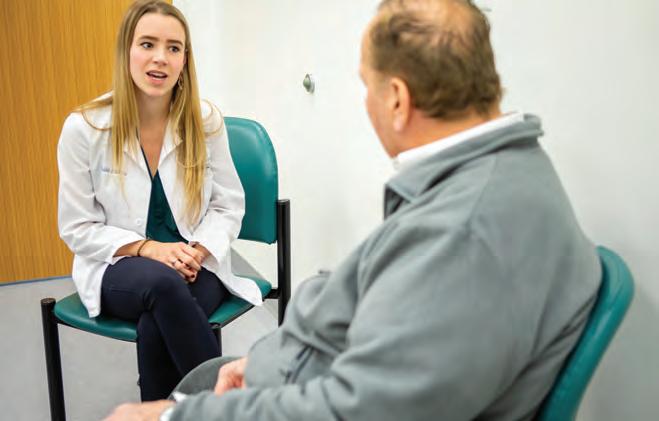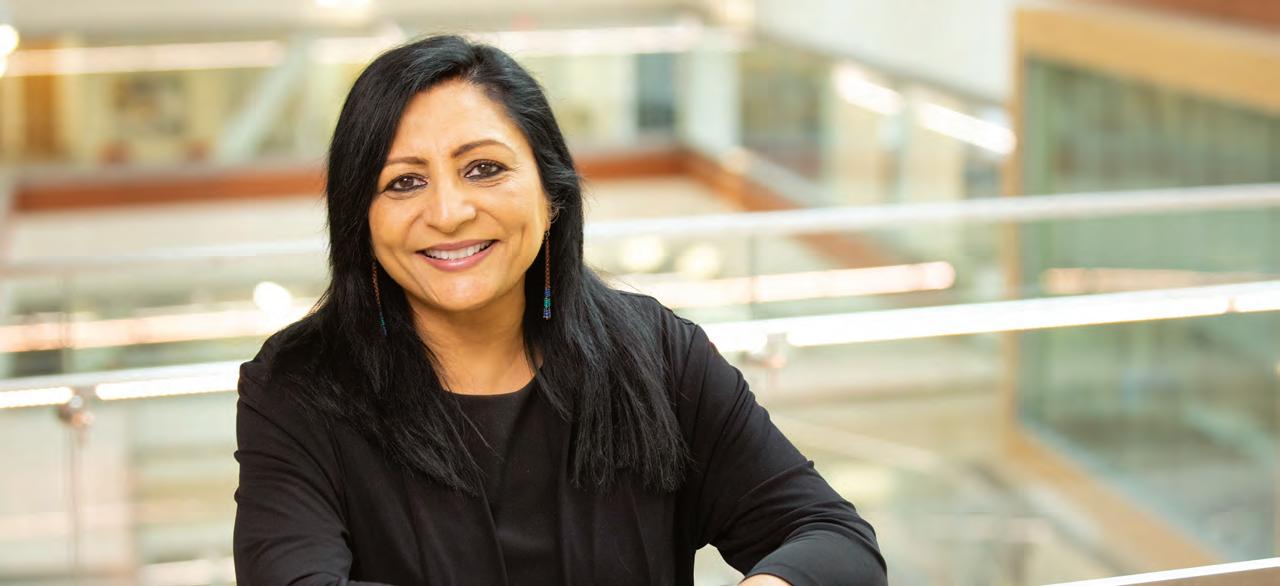
12 minute read
COMMUNICATION AS A FOUNDATION FOR CARE
by UBAA
Teaching good ways to deliver bad news C� unicati� AS A FOUNDATION
for Care




In recent decades, this understanding has grown out of diffi cult lessons that caused medical professionals to step back and acknowledge that high technology, while a tremendous boon, also served to undermine their relationships with patients. This in turn aff ected adherence to treatment plans and patient satisfaction, contributing to an increase in malpractice suits. Recognizing these trends, the Accreditation Council for Graduate Medical Education mandated in 2007 that residents be formally taught communication skills. At about this same time, medical professionals also began acknowledging a responsibility to communicate more eff ectively when talking with patients about life-altering or terminal diagnoses and issues related to informed consent. The Jacobs School of Medicine and Biomedical Sciences anticipated these trends when it established the Standardized Patient Program in its Clinical Competency Center in the early 1990s. The program grew out of concerns that third- and fourth-year students were not being adequately trained in communication skills. Since that time, the program has been expanded to include fi rst- and second-year students, as well as residents. Other courses, established in the late 1990s, focused on teaching students how to compassionately and eff ectively deliver diffi cult news to patients. These groundbreaking programs continue to thrive today and are being expanded by a new generation of faculty devoted to sustaining excellence in this aspect of medical education in the Jacobs School. Early exposure to lifelong skills First-year medical students in the Clinical Practice of Medicine 1 course are introduced to a six-step protocol for how best to present distressing information in a caring and organized manner to patients and their families. Known by the acronym SPIKES, the protocol was developed in the early 2000s by British oncologist edical educators understand that if they focus too heavily on the science of medicine, they risk overlooking the art of medicine, an art perhaps best exemplifi ed by good physician-patient communication. M STORY BY MARK SOMMER PHOTOS BY DOUGLAS LEVERE
Robert A. Buckman, MD, PhD. In the Clinical Practice of Medicine 2 course, second-year medical students are scheduled to take the How to Deliver Bad News module, developed at UB in 1999, which uses actual cancer survivors for role-playing. In their third-year, students participate in three Communication in Serious Illness workshops where they learn how to engage in “values-based” conversations with patients to arrive at a course of action. A palliative-care elective gives medical students an opportunity to learn about hospice and palliative care. This includes their spending time at a facility and making home care visits with doctors, nurses, social workers and chaplains. Students also take part in team meetings and family conferences. First-year surgical residents at UB are required to spend a week in the palliative care elective. Jason Edwards, MD ’16, chief resident in internal medicine at Erie County Medical Center (ECMC), says the training he received in physician-patient relationships at the Jacobs School has been invaluable. He is particularly drawn to palliative care’s holistic approach. “The first thing you learn to do is listen,” he says. “It’s not about talking and reacting. It’s about taking in a patient’s perspective over a whole lifetime and fusing that into their care. “It takes time, and it takes patience,” Edwards adds, “but it forms a foundation to make decisions about their health care and empowers them to make decisions aligned with their values. When done correctly, it is a communal endeavor more than a hospital-system endeavor.”
Learning from patients In the late 1990s, Hillary Ruchlin, former director of the Cancer Wellness Center in Buffalo, approached Alan Baer, MD, thenassociate professor of medicine at UB, about using actual cancer survivors instead of commonly used scripted actors to help medical students understand how best to inform patients that they have cancer. Ruchlin had been troubled by the accounts she had heard about how poorly doctors, in general, had delivered bad news to patients.
“It’s a life-altering moment,” Ruchlin says. “I had thought that communicating with cancer patients was something they taught medical students, so it was news to me when I learned that they didn’t.”
Baer turned to Buckman’s pioneering work to develop materials. He was aided by Jack Freer, MD ’75, a UB clinical professor of geriatrics and palliative medicine, who teaches students about SPIKES and oversees the palliative care elective. The How to Deliver Bad News module began in 1999 in a large lecture hall and later moved to more intimate settings, where it was presented to groups of 24 students. Cancer survivors volunteered to participate in the module, willing to relive painful memories to help the next generation of physicians be more compassionate about how they talked to patients with difficult diagnoses. Ruchlin says the medical students were captivated by the cancer survivors’ stories of how physicians had informed them of their cancer. “You could tell just by looking at them that they were very immersed in and affected by what these people had gone through,” she recalls. “This is a very important moment in a patient’s life, one they’re never going to forget, and doctors need to be aware of the situation,” she says. The medical students in the module also role-play with survivors, who pretend to be patients. To do this, the students present a fictitious case history they’ve been informed about prior to the 20-minute session in which they interact with the patient. After this practice exchange, five minutes are allocated for the patient to give
Eric Hansen, MD, assistant professor of medicine in the Jacobs School of Medicine and Biomedical Sciences, and palliative care physician at Roswell Park Comprehensive Cancer Institute, teaching How to Deliver Bad News module.


Donna Price, RN, Erie County Medical Center, left, and Jason Edwards, MD ’16, chief resident in internal medicine at ECMC, right, teaching Communication in Serious Illness Workshop.

Katie Grimm, MD ’93, clinical assistant professor of medicine, right, teaching Communication in Serious Illness small-group workshop at Erie County Medical Center (ECMC).


Sandra Lauer, BSN, RN, at ECMC, co-leads the workshop with Katie Grimm, MD, and Mehak Swami, DO, clinical assistant professor of medicine.
the student feedback on how effectively he or she felt the diagnosis was communicated. The volunteer patient then completes a written evaluation checklist on the student’s performance. Questions include whether the student asked how much the patient wanted to know about his or her illness, and if they used the word “cancer” as opposed to simply “a tumor” or “growth,” and whether the student ended the interview with a polite and appropriate closure. In October 2000, Baer presented an abstract on the project’s findings at the annual meeting of the Association of American Medical Colleges, describing significant differences in the students’ approaches to delivering stressful news based on pre- and post-test results. Baer found that after completing the module, students were more apt to use personal, empathetic and reassuring language rather than impersonal and technically specific language, signaling its success. “When we first started the program, we got calls from doctors who said they wished they had had this opportunity when they were students,” Ruchlin says. Karen Zinnerstrom, PhD, administrative director of the Clinical Competency and Behling Human Simulation centers at the Jacobs School, oversees the How to Deliver Bad News module with cancer survivors. She says that feedback from the second-year medical students consistently demonstrates the value of the module, under course director Nasir Khan, MD, clinical associate professor of medicine. “Of all the small groups that students are exposed to in their first semester, this module receives some of the most positive evaluations,” she explains. “Student comments often include statements such as: ‘Thank you; this is why I came to medical school in the first place.’” In another part of the module, William Potter, a retired research scientist in oncology, discusses the need to “detoxify statistics,” reminding students that statistics are predictive of outcomes for large groups, but make no determination for individuals. “What we say is that it is an individual situation, and you always have to remember that anything is possible,” Potter says. “It’s good medicine to try to get the patient to perceive the situation from a more optimistic point of view.” An ongoing challenge Eric Hansen, MD, an assistant professor of medicine in the Jacobs School and a palliative care physician at Roswell Park Comprehensive Cancer Center, trains students in the Clinical Competency Center. “When we first started the program, we got calls from doctors who said they wished they had had this opportunity when they were students.” —HILLARY RUCHLIN, FORMER DIRECTOR OF THE CANCER WELLNESS CENTER IN BUFFALO
In this role, he talks with students about the personal challenges physicians face when they need to deliver bad news to patients and their families, and ways to cope with the emotional toll it can take on doctors over time. Hansen says it’s good for medical students to have this training as early as possible, but acknowledges that they don’t fully appreciate its importance until they begin working regularly with patients in their third and fourth years and in residency. “We try and support them, acknowledging these conversations are challenging emotionally for all physicians, even experienced physicians,” Hansen says. “It helps to go in prepared, but you’re still dealing with a very difficult and often sad situation. We try to give them skills to work with colleagues—ways to productively debrief with them after the visit—and to develop self-care strategies to deal with inner-personal challenges.”
A factor in burnout The Communication in Serious Illness workshops are led by Katie Grimm, MD ’93, clinical assistant professor of medicine, and Mehak Swami, DO, clinical assistant professor of medicine, both in the Division of Geriatrics and Palliative Medicine, Department of Medicine; and Sandra Lauer, BSN, RN, director, continuum of care, supportive care and palliative medicine at ECMC. For the workshops, the educators use a guide developed by Ariadne Labs in Boston to help teach students how to conduct difficult conversations, Grimm explains.
Second-year student Julie Adams practicing communication skills in the Clinical Competency Center.

All third-year medical students now receive this training as part of the two-week Core Topic intersessions held between fall and spring semesters. The students then have an opportunity to apply these skills in their remaining clerkships to improve communication with patients, families and health care teams. “I think there is a tremendous amount of what we call ‘burnout’ when residents try to deal with difficult situations and come away feeling angry or defeated,” Grimm says. “Their distress may be directed at the patient and the family for not understanding what they are trying to tell them, but it’s because there is a gap in communication at a basic emotional level.” Lauer says it takes time to connect with patients, listening carefully when they express their values and goals. It’s all the more important because patients look to doctors to initiate a conversation, she explains. “We have data that shows physicians are not always comfortable talking about serious illnesses and death,” says Lauer, “yet there is this idea that because physicians are smart people, they should be able to communicate well.” Lauer reports that students respond positively to the training. “Fairly consistently, they say they wish it were longer and that it involved more role playing,” she says.
A powerful thing For Edwards, the chief resident in internal medicine at ECMC, taking the workshops opened doors he has continued to step through in a career he sees as dedicated to palliative care. “It goes from the idea of ‘I don’t know if I should be doing this’ to ‘I have to do this.’ It’s a very powerful thing to do correctly. Once you’re trained in palliative care, it becomes part of your foundation and your thought processes.” Palliative care has changed Edwards’ view of medicine, since he says he now looks at the whole person more. “You go to medical school and learn disease processes, but at a certain point all the concrete knowledge you have is futile,” he observes. “It reaches a point where medicine can only go so far. But with palliative care, there is no end point because you are evaluating the whole ethos of a person. It’s all part of being human beings first, and doctors second.”
PALLIATIVE CARE INTEREST GROUP FORMED
In 2018, Timothy Felong and Samantha Loria, Class of 2021, established a Palliative Care Interest Group in the Jacobs School of Medicine and Biomedical Sciences in an effort to inform their peers about the importance of providing specialized medical care, including better quality of life, for patients living with a serious illness. The students were inspired to form the group after participating in a mercy doula training program at Erie County Medical Center (ECMC) begun by Elder Wiggins, the medical center’s chaplain; Sandra Lauer, BSN, RN, director, continuum of care, supportive care and palliative medicine; and Katie Grimm, MD ’93, director of palliative care, and clinical professor of medicine in the Division of Geriatrics and Palliative Medicine at the Jacobs School. Felong says the training exposed the students to emotionally difficult physician-patient interactions, such as how to talk to dying patients who don’t have family or friends in their lives, and how to listen to patients without judgment. “After completing the program, we wanted to provide an avenue for other students interested in seeking out this type of training, now and into the future,” Felong says. Since its inception, the Palliative Care Interest Group has worked to create opportunities for students to interact with and shadow local palliative care physicians and specialists. Group members also hosted a panel discussion on physician-assisted dying and different approaches to end-of-life care. The Palliative Care Interest Group resonated with Tara Daly, Class of 2022, who now leads it with classmate Maria Geba. “I find that a lot of students feel unprepared when it comes to interacting with a patient who might be facing end of life or decisions around end of life,” Daly says. “I hope we can help expose our colleagues to the field of palliative care—what it is, what it entails and how it fits into the whole field of medicine.” “Palliative care is still a young field,” Geba adds. “Hopefully, what we’re doing will put it on people’s radar.”
A Palliative Medicine Excellence Fund for Medical Students has been established at the Jacobs School. If you are interested in supporting our students by investing in a new model of care in palliative medicine focused on humanism and the reduction of barriers to health equity, please consider giving to this endowment fund. To learn more, contact Jennifer Seth-Cimini, senior director, medical advancement, at jns2@buffalo.edu, or 716-829-3732.







